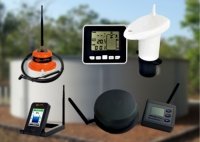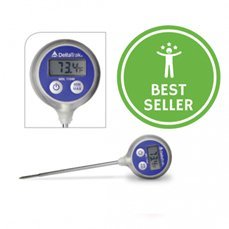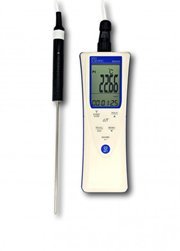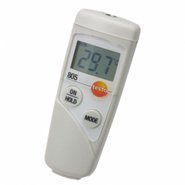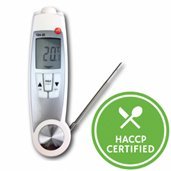The Ultimate Guide to Food Thermometer Types
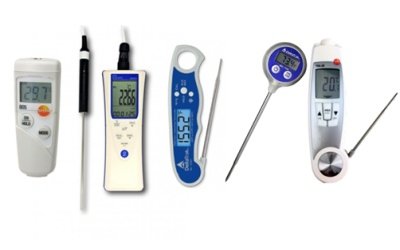
If you store, prepare, cook, transport, or sell food, you need to maintain the correct temperature for your product to ensure food safety and quality. The only way to do this is using a food thermometer.
This article outlines the five main types of food thermometers and provides examples of each type so that you can find the best for your application.
What Are Food Thermometers
A food thermometer is a temperature measuring tool specifically designed to measure the temperature of food and food-related products.
Why Use a Food Thermometer?
A food thermometer is a crucial tool for applications in the food sector. Using a food thermometer has two key benefits:
- Ensure food safety: By helping you confirm that potentially hazardous food is sufficiently cooked and stored safely.
- Achieve desired food quality: Numerous food production tasks require specific temperatures to achieve desired outcomes, e.g., bread baking and chocolate tempering.
What to Look For When Purchasing a Food Thermometer
What to look for in a food thermometer depends on your desired outcomes. Key considerations include:
- Temperature Range: Consider the temperature range you need to measure. Ensure the thermometer purchased can measure the desired range accurately.
- Accuracy: The higher the accuracy, the higher the cost. If your organisation prepares, handles or sells any potentially hazardous food, it must have an accurate thermometer to ±1°C.
- Waterproof Rating: For thermometers used in heavy kitchen environments, you might want to consider a waterproof or water-resistant option.
- Other Functions: HACCP compliance, data logging, calibration, and data hold are examples of common and useful features found in more advanced food thermometer types.
Types of Food Thermometer
To make finding the most suitable food thermometer for your application straightforward, we have organised them into their five main groups below, along with excellent product examples. If you have any questions after reviewing the list of food thermometer types below, speak with an Instrument Choice Scientist!
1. Lollipop/Stem Thermometers
Known as lollipop or stem thermometers, these devices are the most affordable food thermometers for assessing the temperature of liquids and semi-solid foods. They consist of a small LCD screen and a metal shaft thermometer.
Flashcheck Waterproof, Lollipop Thermometer With Reduced Tip
|
2. Folding Thermometers
Folding thermometers have a probe that folds up against the thermometer body. The folding mechanism ensures probe protection when not used and facilitates safe transport.
Product Example:
FlashCheck Waterproof Min/Max Folding Probe Thermometer
|
3. Probe Thermometers
Probe type food thermometers feature a temperature probe located on the end of a cable. This design is beneficial for operators who need to monitor the LCD constantly or when an application requires a custom probe. Further, in the event of accidental damage to the temperature probe, most models have replacement probes that are a fraction of the cost of a new meter.
Product Example:
HACCP Thermometer
|
4. Infrared Thermometers
Infrared type thermometers play a key role in the food industry. However, IR type thermometers will only measure the surface temperature of the foods, not the internal temperature. To measure internal food temperature, you will need a probe thermometer.
IR type thermometers are beneficial for quick temperature checks like sampling the temperature of incoming goods and scanning the surface temperature of skillets and pans.
Product Example:
Testo 805 Mini IR Thermometer with Topsafe
|
5. Dual IR and Probe Thermometers
Dual IR and probe type thermometers offer the best of both worlds. These two-in-one thermometers allow quick surface temperature checks and accurate core temperature checks. Professionals consider dual IR and probe thermometers the gold standard for measuring food temperature in any situation.
Product Example:
Waterproof Infrared & Probe Thermometer
|
Conclusion
Temperature maintenance is the key to preparing, storing, moving, and selling food that’s safe, delicious, and of high quality. The best way to ensure safe temperatures is to monitor the temperature of products using a food thermometer.
Need more information or assistance finding the right food thermometer type for your application? Speak with an Instrument Choice Scientist: Call 1300 737 871 or email [email protected].
Also interesting
Instrument Choice’s team of scientists regularly reviews new and popular products, so you can make more informed decisions when searching for the perfect scientific instrument for your application.
This edition details and reviews the FLIR One Pro Thermal Imaging Camera Attachment, ideal for an assortment of thermal imaging applications commonly undertaken by electricians, mechanical and automotive technicians, and HVAC professionals.
Get your scientists’ review of the FLIR One Pro Thermal Imaging Camera Attachment.
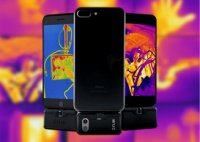
Water tank level monitoring helps to optimise your tank water management and ensure peace of mind. A complete tank monitoring kit will allow you to detect and repair any issues before they escalate and become a headache.
In this guide, your Instrument Choice Scientists detail exceptional examples of tank level monitoring kits that include all the necessary components to set up and start monitoring tank levels from the comfort of your office or living room.
Be confident that there will be water there when you need it. Find the right tank level monitor for your needs here.
